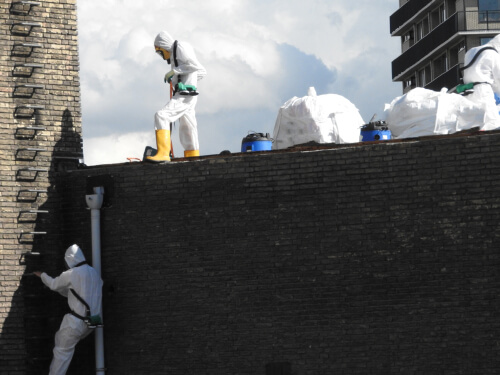Asbestos Exposure at Job Sites in Massachusetts

Up until the 1970s, asbestos was widely used on many job sites. This left workers exposed to the deadly fibers, with little to no protection.
Today, many of those same workers are suffering from serious illnesses such as mesothelioma, a very aggressive form of cancer caused by asbestos exposure.
If you believe you have developed an illness due to asbestos exposure at work or somewhere else, it’s important to speak to a Boston asbestos lawyer as soon as possible. An attorney from The Law Offices of Michael P. Joyce, P.C., can conduct an investigation to prove your case and help you seek the compensation you deserve.
Where Was Asbestos Used in Massachusetts?
Asbestos was used in many applications, exposing potentially millions of people to this harmful substance. Below are just a few of the job sites where the asbestos was extremely prevalent and caused significant harm.
- Manufacturing facilities – Early in the 20th century, asbestos was thought to be a very promising material. It was cheap, lightweight, heat-resistant, and in abundant supply. Many factories and manufacturing facilities used it to improve production and profits. Workers in manufacturing facilities often worked with raw asbestos as well as products that contained asbestos.
- Power stations and utility plants – Asbestos was used in power stations and utility plants due to the fact that it can stand up to immense amounts of heat. It was used in machinery such as boilers, pipes, and turbines. Over time the asbestos would deteriorate, leaving workers exposed to fibers. The protective clothing such as aprons and masks these workers wore also contained asbestos.
- Wastewater treatment plants – Between the 1950s and 1980s, asbestos was used in wastewater treatment plants to insulate the walls of water tanks. Anyone who worked in these plants, particularly around the tanks, could have been exposed.
- Boiler plants – For decades, virtually every boiler in America was insulated with asbestos. Boilers are complex machines and every part of these systems requires heat control that traps heat inside the boiler tanks and delivery pipes. Asbestos was an ideal choice for this, except for the fact that its fibers can be deadly.
- Shipyards – Asbestos was widely used in shipyards because it resists corrosion and high temperatures. In shipyards, it was used to insulate boilers, incinerators, hot water pipes, and steam pipes. In the 1970s, the government started to remove asbestos from ships and replace it with asbestos-free insulation. That job is not yet completed and asbestos is still found in many ships.
- Military bases – For years, the United States military constructed nearly every element of military bases using asbestos. It was used in ships, tanks and other equipment, and was also used in the construction of the living quarters of people serving their country.
- Hospitals – Hospitals used asbestos in large boiler houses, as lagging on steam pipes under floors and subways, and for insulating pipework. This exposed not only hospital workers to the dangerous fibers, but also patients and visitors.
- Government buildings – Due to the fact that asbestos is fireproof, it was used in the construction of nearly every building in the United States until the 1980s. This included government buildings. Asbestos is also very strong, making it ideal for use in roof shingles, pipes, siding, wall board, and many other construction materials.
- Schools and colleges – During the 1950s and through to the early 1970s, asbestos was widely used in schools because it had acoustical benefits, was fireproof, and was even considered decorative. This exposed not only teachers and other workers in the school to the harmful effects of asbestos, but also children who would not feel the effects until decades later.
- Homes and apartment buildings – Asbestos was used in the construction of homes until the dangers of the substance became known in the 1970s. It was used in floor and ceiling tiles, roof shingles, siding, insulation, pipe cement, and joint compound in sheetrock. Asbestos remains in many older homes today.
- Malls and stores – Like any other type of construction, asbestos was used for similar reasons, such as providing insulation, in malls. However, malls do have a unique asbestos application. When these shopping centers switched from covering their flooring with carpet to tiles, the tile had to be applied with a cement adhesive, which often contained high levels of asbestos.
Many buildings, such as military bases, malls, homes, and schools, still contain large amounts of asbestos. Today, this deadly substance is still putting millions of people at risk.
Occupations Exposed to Asbestos
With asbestos being widely used in so many applications, millions of people had to work around it every day. Today, there are still many workers who are at particularly high risk for suffering the negative effects of working around asbestos. Some of these occupations include:
- Boiler workers – Individuals who work around boilers have some of the highest risk for exposure to asbestos. Many parts of this job involve working around asbestos. For example, boiler workers once needed to cut rounds of insulation to cover stretches of pipes. This created even more asbestos dust that workers inhaled.
- Insulation workers – Before the harmful effects of asbestos were known, virtually any time insulation was installed in any building, asbestos was used. This put insulators at great risk, particularly when insulation would break and fibers would float in the air.
- Pipefitters – Asbestos was used as a primary component of pipe insulation until the middle of the 1980s. Before that time, asbestos was used almost every time pipes were installed.
- Bricklayers – When working on different job sites, bricklayers were often exposed to asbestos. Pipes wrapped in asbestos, insulation, glue, and cement were all made with asbestos, and bricklayers were exposed to all of these materials.
- Construction workers – These workers also have some of the highest risk of developing mesothelioma and other asbestos-related diseases. This is largely because so many construction materials contained asbestos. Many construction jobs involve demolitions and remodeling jobs, which put even more asbestos fibers into the air.
- Plumbers – Plumbers were exposed to asbestos in two main ways. The first was when they would manually adjust materials that contained asbestos, releasing tiny fibers into the air. When products were old and no longer useful, plumbers would tear them out, also putting more asbestos fibers into the air.
- Electricians – Electricians have to install wires in walls, ceilings, and crawl spaces. These spaces are often full of asbestos. Electricians also have to remove insulation around old wiring and inside breaker boxes, which also contain asbestos.
- Painters – It may not seem as though painters are at high risk for asbestos exposure, but they are. Even today, asbestos cannot always be removed completely. When painters have to work around these areas, they are at risk for asbestos exposure. Painters also often have to paint over roof tiles, which often contain asbestos.
- Plasterers – Plaster is made up of cement, fibers, and an aggregate. The fibers used to make plaster often contained asbestos because it was soundproof and durable. When plasterers mix dry plaster or cut into dried plaster, it releases asbestos fibers into the air.
- Shipyard workers – Asbestos was once used widely in ships. Anyone who worked in a shipyard was likely exposed. Even when workers did not come directly into contact with asbestos, they were still at risk for secondary exposure.
- Mechanics – Brake pads, brake linings, clutch facings, and other auto parts once contained high levels of asbestos. When mechanics changed or worked on these parts, it released asbestos brake dust into the air.
- Firefighters and rescue workers – When buildings are on fire, the structures containing asbestos collapse, releasing the dangerous fibers into the air.
- Service members – The U.S. military used asbestos in most buildings and equipment such as tanks and ships. Millions of service members have become exposed. Although much of the asbestos has been removed, there are areas where asbestos remains and poses a risk to people in the military.
There may be many different types of compensation available for individuals who contract an asbestos-related illness. When someone develops one of these illnesses due to the nature of their employment, they are usually eligible for workers’ compensation benefits. Other forms of compensation may also be available depending on the circumstances.
Our Law Firm Knows Where Exposure Occurred
People who contract an asbestos-related illness may file a personal injury lawsuit against the manufacturers that knowingly supplied the products that contained the harmful fibers. Many of those companies have gone out of business, but have created trust funds to provide compensation to victims.
In either of these situations, sick individuals must still prove that they were exposed to asbestos and that a specific company is liable for that exposure.
These are difficult things for individuals to prove on their own, but a Massachusetts asbestos lawyer can help. An attorney can take depositions of the sick individual. During this deposition, the person suffering from an illness will provide their personal and employment history, which can help prove how and when they were exposed to asbestos. An attorney can also further investigate by contacting co-workers, searching records and query databases, and examining company records.
An attorney can do all of this to help victims of asbestos-related diseases secure the compensation they need.
Talk to an Asbestos Lawyer Now
If you have developed an illness such as mesothelioma and believe it was caused by asbestos exposure at work, you need to speak to a Massachusetts asbestos attorney right away.
These cases can be difficult to investigate and pursue, particularly for individuals who are not familiar with the process. At The Law Offices of Michael P. Joyce, P.C., our attorneys are prepared to conduct a thorough investigation to prove liability and seek the compensation you need and deserve.
If you’ve developed an asbestos-related sickness such as cancer, call us today so we can start discussing your case. The consultation is free and confidential.

